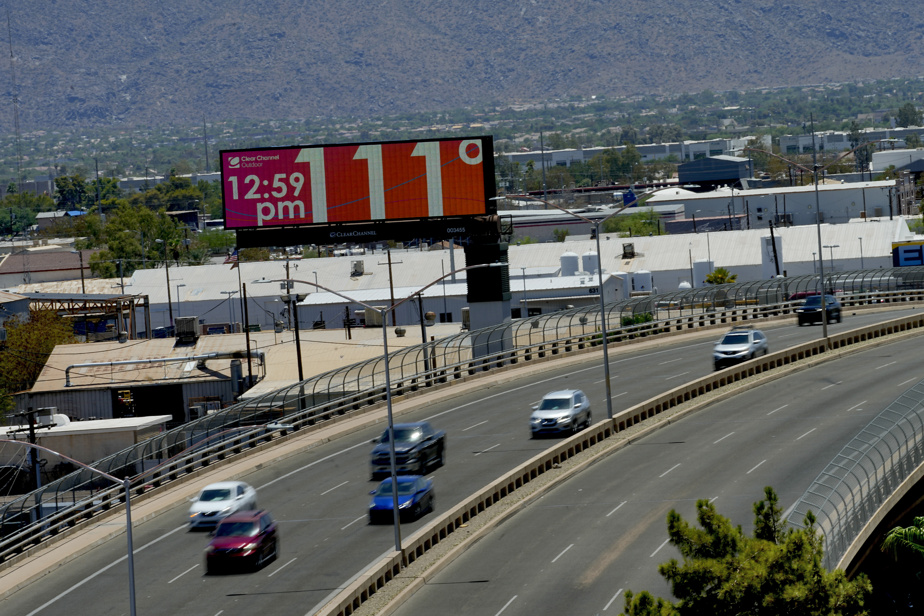(Phoenix) Phoenix’s unbroken streak of dangerously hot days was finally set to break a record for major US cities on Tuesday, the 19e consecutive day the desert city saw temperatures soar to 43.3°C or more.
The night brought little relief from these brutal temperatures. On Monday, Phoenix recorded its lowest overnight temperature (35°C), surpassing the previous record of 33.8°C set in 2009. It was the eighth day in a row that the mercury did not slip below 32 2°C, another record. This figure increased to nine days in a row with the night from Tuesday to Wednesday, when temperatures dropped to 34 degrees.
It’s “pretty miserable when you can’t recover overnight,” said Matt Salerno, a meteorologist with the US National Weather Service.
The duration of the heat wave sweeping through Phoenix is remarkable, even in a summer when much of the southern United States and the entire world experienced record high temperatures ― which scientists say is fueled by climate change.
What is happening in the metropolitan area known as the “Valley of the Sun” is far worse than a brief surge in the thermometer and poses a health hazard to many people, experts say.
“Long-term heat exposure is more difficult to bear than isolated hot days, especially if the nighttime cooling is not enough to sleep well,” said Katharine Jacobs, director of the Center for Climate Adaptation Science. and Solutions from the University of Arizona.
The last time Phoenix didn’t hit 43.3°C was on June 29, with 42.2°C. The 18-day record above 43C that was equaled on Monday was first set in 1974, and it looks set to be broken with higher temperatures predicted through the end of the week.
“This phenomenon is very persistent,” said Isaac Smith, a meteorologist with the National Weather Service. This trend appears to be continuing. »
No other major US city has had a longer streak of 43°C days or 32°C nights than Phoenix, said weather historian Christopher Burt of the Weather Company.
Russ Vose and Ken Kunkel, US government climate data scientists, found no major city that experienced such a heat wave, but smaller localities such as Death Valley and Needles in California and Casa Grande in Arizona experienced longer periods.
Death Valley had an 84-day streak of 43C temperatures and a 47-day streak of overnight temperatures not dropping below 32C, Vose said.
According to Randy Cerveny of Arizona State University, who coordinates verification of weather records for the World Meteorological Organization, the Phoenix heat wave has both long-term and short-term causes.
“The long-term cause is the continued increase in temperatures over the past decades due to human influence on the climate, while the short-term cause is the persistence, in recent weeks, of a very strong ridge of high pressure over the western United States,” he said.
This high, also known as the heat dome, circled the southwest for weeks, and as it moved, it centered more on Phoenix than ever, Smith said.
The entire southern United States is under a heat dome, with temperature records broken from California to Florida, and the globe itself the hottest on record for much of the summer.
The southwest high also prevents rains and cooling clouds from bringing relief, Smith said. Normally, the monsoon season in the southwest starts around mid-June. But Phoenix has not received any measurable rainfall since March.
The heat wave is “a harbinger of things to come, given that the most reliable predicted impacts of climate change are those directly linked to rising global temperatures,” Jacob said.
Since 1983, Phoenix’s average daily summer temperature has risen 2 degrees Celsius, daily high temperature has risen 1.8 degrees Celsius and nighttime low temperature has risen 2.4 degrees Celsius, according to NOAA, a federal agency. American.
“Climate change and district heating are certainly exacerbating warmer temperatures and making them more frequent,” Smith said.
These heats can hit the native country hard. According to Mr. Jacobs, about 30% of the population of the Hopi and Navajo reservations do not have running water or air conditioning and are not near refreshment centers. This situation is all the more unfair since “tribal members have contributed very little to the concentrations of greenhouse gases”, he believes.
Jonathan Patz, a professor of health and environment at the University of Wisconsin-Madison, explains that the urban heat island effect is another aspect of heat waves that disproportionately affects some communities: cities warm because of buildings and the lack of trees and green spaces.
A study published two years ago in the journal NatureCommunications showed that people of color face more extreme temperatures than non-Hispanic whites.
Hispanic-majority neighborhoods in Phoenix tend to have fewer trees than other parts of the city.
One of the city’s hottest neighborhoods is Edison-Eastlake, a historically black-turned-mostly Latino neighborhood, where temperatures have in recent years reached up to 10 degrees Fahrenheit warmer than in other parts of the city.
